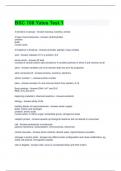BSC 108 Yates Test 1
3 domains or groups - Answer-eukarya, bacteria, archae
4 basic macromolecules - Answer-carbohydrates
proteins
lipids
nucleic acids
4 kingdoms in Eukarya - Answer-animalia, plantae, fungi, protista
acid - Answer-releases H+ to a solution, 0-6
amino acids - Answer-20 total
consists of central carbon atom bonded to 4 covalent partners in which 3 are common to all
atom - Answer-smallest unit of an element that has all of its properties
atom composed of - Answer-protons, neutrons, electrons
atomic number = - Answer-proton number
base - Answer-accepts H+ and removes them from solution; 8-14
Base pairings - Answer-DNA: A>T and G>C
RNA: A>U and G>C
beginning material in chemical reactions - Answer-reactants
biology - Answer-study of life
building blocks of macromolecules - Answer-carbs: sugars
lipids: carbon and hydrogen
proteins: amino acids
nucleic acids: 5 carbon sugar, phosphate group, nitrogenous base
catalytic protein - Answer-speeds up biological reactions but not altered or consumed
cell - Answer-prokaryotic or eukaryotic
plasma membrane, cytosol/plasm, chromosomes, ribosomes
central vacuoles - Answer-store nutrients, absorb water, pigment/poison possible
changes in amino acids - Answer-can affect protein configuration and cause malfunction. eg
sickle cell anemia, hemoglobin peptide
cilia vs flagella - Answer-cilia: move in coordinated back and forth motion
, flagella: propels cell in whip like motion
cohesion and adhesion - Answer-attraction between like and unlike molecules
common themes in biology - Answer-scope of life, organisms exchange matter and energy, cells
are basic unit of life, continuous life based on DNA, diverse life forms, evolution
components of hypothesis - Answer-support or reject hypothesis with data, not all can be
investigated scientifically, must be testable
cytoplasm - Answer-area within the membrane not including organelles, cytosol
dehydration reaction - Answer-removal of water, 2 molecules covalently bonded through lost
water molecule
difference between simple and complex carbs - Answer-chemical structure, how it is digested
and absorbed, simple sugars and starches
disaccharides - Answer-double sugar, dehydration, lactose, sucrose
diseases of protein misconfiguration - Answer-mad cow disease, prion disease, alzheimers,
parkinsons
DNA bases - Answer-Adenine
Guanine
Cytosine
Thymine
DNA vs RNA - Answer-DNA is double helix and uses thymine, RNA is single stranded and uses
uracil
electrons in energy shells - Answer-1st shell: 2 electrons
2nd shell: 8 electrons
3rd shell: 8 electrons
ending material in chemical reaction - Answer-products
endomembrane system - Answer-endoplasmic reticulum, golgi apparatus, lysosome, vacuoles,
nuclear envelope
endoplasmic reticulum - Answer-proteins made on ribosomes
rough ER: modify membrane & secratory proteins, produces new membranes
smooth ER: produces lipids, houses detoxify foreign molecules
energy - Answer-capacity to do work, make a change in matter; potential energy is stored in
bonds, kinetic is doing work
eukaryotic - Answer-animals, plants, fungi
fluid mosaic membrane - Answer-membrane structure with high diversity of proteins




